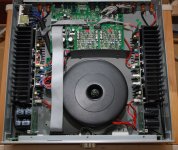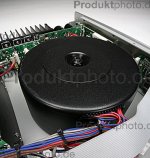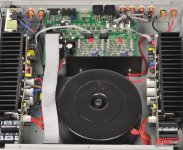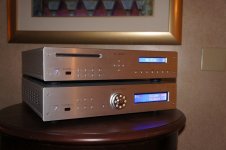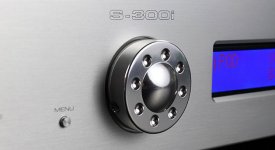Concerning Krell's lowest cost integrated amplifier I read about
6moons audio reviews: Krell S-300i
follow:
"The really big surprise is the silk screen: "Manufactured In China Under ISO 9001 Quality System". Yes, the cheapest Krell integrated is made in China in a modern factory with ISO certification."
More URLs:
Krell S 300i: STEREO | Zeitschrift für HiFi, High End & Musik
????KRELL S300I??_HIFI??_????????-????-???? - Powered by ECShop
Krell S300i im Test: Amerikanisches Kraftpaket - sempre-audio.at
Who knows this factory?
Perhaps about
ºñ»ý±¡·¢ ÆÀKrell S300iºÏ²¢¹¦·Å - Ó°ÒôÖйú ¡ª¸ßÇå¡¢¼ÒÍ¥Ó°Ôº¡¢ÒôÏì¡¢µçÓ°¡¢µçÊÓ¡¢ÒôÀÖµÄרҵӰÒôÍøÕ¾
are to find some informations.
6moons audio reviews: Krell S-300i
follow:
"The really big surprise is the silk screen: "Manufactured In China Under ISO 9001 Quality System". Yes, the cheapest Krell integrated is made in China in a modern factory with ISO certification."
More URLs:
Krell S 300i: STEREO | Zeitschrift für HiFi, High End & Musik
????KRELL S300I??_HIFI??_????????-????-???? - Powered by ECShop
Krell S300i im Test: Amerikanisches Kraftpaket - sempre-audio.at
Who knows this factory?
Perhaps about
ºñ»ý±¡·¢ ÆÀKrell S300iºÏ²¢¹¦·Å - Ó°ÒôÖйú ¡ª¸ßÇå¡¢¼ÒÍ¥Ó°Ôº¡¢ÒôÏì¡¢µçÓ°¡¢µçÊÓ¡¢ÒôÀÖµÄרҵӰÒôÍøÕ¾
are to find some informations.
Attachments
Last edited:
The surprise to me is its using lots of op amps like OP177G.
I don't believe thats even an audiophile type, very low bandwidth and slew rate.
I don't believe thats even an audiophile type, very low bandwidth and slew rate.
can be used in servo and other DC monitoring type functions
mlloyd1
mlloyd1
The surprise to me is its using lots of op amps like OP177G.
I don't believe thats even an audiophile type, very low bandwidth and slew rate.
From the 6moons review:
"The preamplification circuit is built around four ICs per channel using the Analog Devices OP177 in the starring role. This is one of the newest and best ICs of its kind, with low distortion and noise. It is also characterized by very good linearity."
Mostly SMD's. What happened to discrete transistors from Krell?
"The preamplification circuit is built around four ICs per channel using the Analog Devices OP177 in the starring role. This is one of the newest and best ICs of its kind, with low distortion and noise. It is also characterized by very good linearity."
Mostly SMD's. What happened to discrete transistors from Krell?
Look about follow thread and the posted URLs there:From the 6moons review:
"The preamplification circuit is built around four ICs per channel using the Analog Devices OP177 in the starring role. This is one of the newest and best ICs of its kind, with low distortion and noise. It is also characterized by very good linearity."
Mostly SMD's. What happened to discrete transistors from Krell?
http://www.diyaudio.com/forums/soli...ke-pure-classa-se-despite-low-idle-power.html
yes it states pretty clearly thats what it means =P he's started his own company after being forced out. so now they are going for the quick buck
I dug up the review mentioned by tmblack.
The datasheet for the OP177 gives a slew rate of 0,3V/us. I don't see how such a thing would have any business in the signal path. Especially in a state of the art design that claims not have any capacitors in said path. They are probably there for some sort of DC control. Hardly a starring role.
[FONT=Arial,Helvetica,Geneva,Swiss,SunSans-Regular]The inside is typical for a high-class modern integrated. The input signal runs to a big PCB near the back plate. Almost all of the parts are SMD and the inputs are switched to ICs. The signal from the RCAs leads out with short shielded cables and the XLRs are soldered directly to the PCB. The analog-domain volume control is regulated by a bank of chips. The preamplification circuit is built around four ICs per channel using the Analog Devices OP177 in the starring role. This is one of the newest and best ICs of its kind, with low distortion and noise. It is also characterized by very good linearity. Although two Wima capacitors are visible at the inputs, those are employed only for voltage filtering. This amplifier uses no capacitors anywhere in the signal path. Between sections, the signal progresses in current mode to allow for extended high-frequency response. In the menu we can set input names, gain, balance and fix a given input at unity gain to integrate it with a home cinema system. [/FONT][FONT=Arial,Helvetica,Geneva,Swiss,SunSans-Regular]
[/FONT][FONT=Arial,Helvetica,Geneva,Swiss,SunSans-Regular]The output sections are bolted directly to the lateral heat sinks. Each is based on four multi-emitter Sanken LAPT transistors in push-pull. Voltage gain and current buffer stages both operate in class A but the latter employs 'floating' mode, indicating a dynamically tracking bias. A very big shielded 750W toroid takes up center stage. It runs separate secondaries for the output stage, preamplification stage and control units. The filter capacitance is a significant 38000μF.[/FONT]6moons audio reviews: Krell S-300i
The datasheet for the OP177 gives a slew rate of 0,3V/us. I don't see how such a thing would have any business in the signal path. Especially in a state of the art design that claims not have any capacitors in said path. They are probably there for some sort of DC control. Hardly a starring role.
I dug up the review mentioned by tmblack.
The datasheet for the OP177 gives a slew rate of 0,3V/us. I don't see how such a thing would have any business in the signal path. Especially in a state of the art design that claims not have any capacitors in said path. They are probably there for some sort of DC control. Hardly a starring role.
Without the benefit of having seen schematics of the S300i I'd tend to agree with ingeneus that the OP177s probably aren't used in the signal path.
Since this seems to be a DC-coupled design, there must be some circuitry that monitors and corrects for DC offset and offset drift. There are quite a few more connections between pre amp and power amp (ribbon cable) than needed for the audio signal alone... so, who knows?
Based on the frequency response of the S300i Krell has on its website:
Frequency response
20 Hz to 20 kHz +0, -0.05 dB
<2 Hz to 1.0 MHz +0, -3 dB
... I'd say the OP177 is not in the signal path. Closed loop response of the OP177 at 0 dB gain has already rolled of 5 dB at 1M, at 20 dB it's already rolled of 5 dB at 100 kHz...
Last edited:
I think, you are right. AboutWithout the benefit of having seen schematics of the S300i I'd tend to agree with ingeneus that the OP177s probably aren't used in the signal path.
Since this seems to be a DC-coupled design, there must be some circuitry that monitors and corrects for DC offset and offset drift. There are quite a few more connections between pre amp and power amp (ribbon cable) than needed for the audio signal alone... so, who knows?
Based on the frequency response of the S300i Krell has on its website:
Frequency response
20 Hz to 20 kHz +0, -0.05 dB
<2 Hz to 1.0 MHz +0, -3 dB
... I'd say the OP177 is not in the signal path. Closed loop response of the OP177 at 0 dB gain has already rolled of 5 dB at 1M, at 20 dB it's already rolled of 5 dB at 100 kHz...
OP177 | Ultra-Precision Op Amp | Operational Amplifiers (Op Amps) | All Operational Amplifiers | Analog Devices
I read follow:
The OP177 features one of the highest precision performance of any op amp currently available. Offset voltage of the OP177 is only 25 μV maximum at room temperature. The ultralow VOS of the OP177 combines with its exceptional offset voltage drift (TCVOS) of 0.1 μV/°C maximum to eliminate the need for external VOS adjustment and increases system accuracy over temperature.
Thus it would be nonsense to use such an OP Amp as line or RIAA gain stage/buffer stage.
Last edited:
- Status
- Not open for further replies.
- Home
- Amplifiers
- Solid State
- Krell S300i Integrated Amp "Made in China" which Factory?
